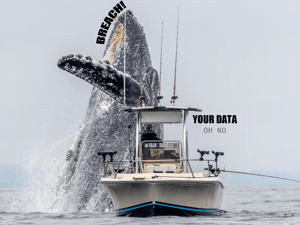
Non-profits have unique needs when it comes to compliance - like a lot of extra rules and regulations that they have to follow that other companies don’t have to worry about. You know, like strict record keeping and financial reporting requirements, limits on political activities and lobbying, restrictions on fundraising and charitable activities, and more.

All of these extra rules mean that as a non-profit, you have to dedicate extra time and resources to making sure you stay compliant - whatever that looks like for your own organization. Since we know what a headache it can be, we put together a compliance checklist so you can take a broad look at where you find yourself right now. In the spirit of accountability and responsibility, here is the checklist with some of the top things non-profits should consider when reviewing their compliance policies & procedures:
1. Intuitive Interface Design: Non-profit teams like legal, HR, and management need to be able to use the security and compliance solution easily. If the "solution" is complex and the average person can't use it, it's not much of a solution, is it? You need to have an intuitive design that is easy to navigate and makes being compliant the easiest and most natural choice.
2. Search Indexing, Tagging, and Automated Document Organization: Compliance isn't always about keeping data secure, but also keeping it organized properly. It should be easily searchable, otherwise you may run into issues where people start keeping sensitive data in unsecured locations - simply because it is easier for them to access and do their job. Kinda goes back to #1 when we said that being compliant needs to be the easiest and most natural choice.
3. Pre-Configured Search Templates: Speaking of easily accessing data, pre-configured search templates that make it easy for your non-technical teams to quickly find what they need. Imagine the templates are like a set of instructions that help people find the documents they need. This is especially beneficial for people that are not very good with computers because it makes it easier to find the right documents quickly.
4. Flexible Policy Creation: Having flexible policy creation is something that helps non-profits follow rules and keep everyone safe. It basically means that you, the non-profit, can create your own rules and decide how long you should keep records. Having your own policies can actually help you stay in line with the laws and keep everyone safe.
5. Enforced Litigation Holds: Don't skip this one because it says "litigation" and you might not be involved with the law (you outlaw, you), because this is still for you! It means that you can put a "lock" on certain documents so that not just anyone can access them. This keeps the documents safe, and makes sure that no one can get access to sensitive data without permission. It's called a litigation hold just because it is used to keep documents secure during a legal process, but any company or organization that deals with sensitive information can use litigation holds to make sure that the documents are kept secure and not tampered with.
6. Extensive Library of Data Connectors: Think of a library of data connectors like a library of books, but instead of books, it stores information on how different systems connect and communicate with each other. This is especially helpful for non-profits because it helps you keep your data up to date and accurate, which is important for compliance.
7. Encrypted, Redundant, and Highly Available Cloud-Native Storage: Your cloud-native storage is like a very big and safe bank vault. It stores information in a way that it is protected (with encryption!) from unauthorized access and is always available. You don't want unauthorized people accessing that data, and it's important that it be available at any time. ← That sentence is an example of negative redundancy. But in the case of compliance, redundancy is a positive because it creates multiple copies of the data that it stores. So if one copy of the data gets lost or corrupted, the other copies can still be used.
8. Integrated Email Security and Encryption: You may have email security, and you may also already have encryption. But are they integrated? Making sure that they are connected and working together makes sure that only the people who are allowed to access certain data can view it and no one else. This is a crucial part of preventing data breaches.

9. Flexible Enforcement of Data Loss Prevention (DLP) Regulatory Violations: To be clear, flexible enforcement doesn't mean that non-profits can decide if they want to enforce rules and regulations related to data loss prevention, but rather how they want to. For example, if a non-profit needs to have their data encrypted, they may be able to have a few months to implement the encryption without being penalized. This flexibility ensures compliance while allowing time to adjust. It gives you the flexibility to pivot if necessary and still comply with your rules and regulations.
10. Continuous Updates of Pre-Configured DLP Policies: Non-profits may have their own unique policies and regulations in place, but you need to stay up to date on changing DLP policies and regulations. They can be used to help you quickly and easily set up your own policies, but remember to keep the foundation up to date so all data is secure and kept safe.
11. Automated Enforcement of Encryption: Set up a system that automatically encrypts your data and requires no user intervention. The old way is having someone manually encrypt data before it's sent to others. Ain't nobody got time for that. Automated all the way!
12. Automated Best Method of Encryption Enforcement: Speaking of automated encryption, your compliance solutions should provide automated best method of encryption enforcement for optimal recipient experience. When your system automatically encrypts data when it is sent to other people, it ensures that the data is kept safe and secure and only the people who are supposed to be able to access the data can actually do so. This really comes into play when communicating with outside parties.
13. Two-Way Encryption Delivery: Last in the vein of encryption is two-way encryption deliver. It's not just about encrypting data that you send out, but making sure that whatever is coming back to you is also encrypted. Can you imagine sending someone an encrypted email with a bank account number, that person replies with the account number but it's not encrypted? Yikes. With two-way encryption, both sender and recipient have to have the same encryption key to access the data.
14. DLP Incident Remediation Workflow: In the event of a breach, you need to have a plan to make sure that any potential data leaks are identified and taken care of quickly. Take action to identify and address any possible data security gaps to ensure that sensitive information is kept safe and secure.
15. Zero Cost Data Import or Exports: Different systems can mean different software programs, databases, or other tools that are used to store or work with data. This has the potential to increase costs and risks, so if your systems aren't already transferring data (securely - we can't stress that enough) between each other for free, it's time to revisit the systems you are using.
By implementing security and compliance solutions with this checklist in mind, you can be sure that your data is safe and that your non-profit is following the necessary rules and regulations to stay compliant and SUCCEED! Because trust us - the hackers and the authorities are always watching.

And if you need help taking into account all the important factors to ensure that you are staying compliant, secure, Ripple is here to help. Go ahead an book your no-obligation consultation and ask whatever questions you may have. We are here to help!
Ripple's IT Team
Don't Fall Behind!
Get the latest work-from-home and Humans First® IT tips straight to your inbox.

